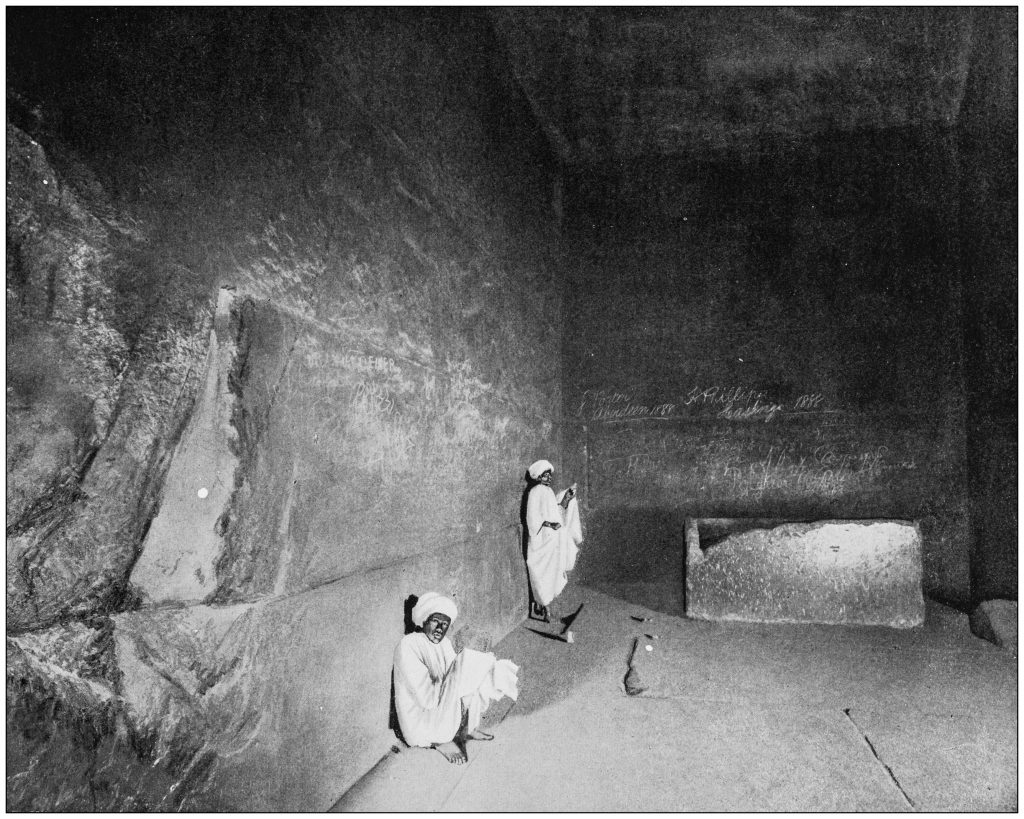Christopher Dunn, The Giza Power Plant: Technologies of Ancient Egypt, Bear & Co., Santa Fe, NM, 1998.
Despite having been created at least 4,500 or more years ago, the Great Pyramid at Giza, Christopher Dunn reminds us, is the “largest, most precisely built, and most accurately aligned building ever constructed in the world”. It has, Dunn adds, “no parallel in modern times.” Dunn is a professional engineer and craftsman with thirty-five years of experience. He makes use of this background to attempt to determine, beyond all the myths, legends, and conventional history, how the astonishing Great Pyramid at Giza may have actually been constructed along with its potential purpose. His conclusion is that it certainly wasn’t all accomplished using crude soft-metal copper tools, ropes, and pulleys. Instead, he sets out detailed evidence that the Great Pyramid was created using far more advanced technologies, themselves the products of a now long-lost but extremely capable civilization.
The Great Pyramid contains an estimated 2,300,000 blocks of stone, both limestone and granite, weighing between 2 ½ and 70 tons each. Dunn cites numerous experts in a variety of trades and fields who also share his belief that, even by the standards of our own time, many of the technologies employed in creating the Great Pyramid are highly developed. In some instances, they are even beyond our present capabilities. He describes, for example, how the massive interior limestone blocks leading to the King’s and Queen’s Chamber, from which the rectangular passages that create a way into them had been cut, were fitted together at complex angles with stunning precision. The total thirteen-acre base of the Great Pyramid is only 7/8 of one inch from being totally level and even this divergence may be the result of gradual subsiding of the ground below.

The ceiling of the King’s Chamber includes nine enormous red granite beams measuring up to twenty-seven feet long and weighing up to seventy tons each. Four more layers totaling seventy more massive red granite beams are positioned above them. The Pyramid’s outer casing blocks, weighing 16-20 tons each, are square and level to within 1/100 of an inch over spans of thirty-five feet and are fitted together with only 1/125th of an inch between them. Inside this gap, cement was used that bonded them together so solidly that the strength of these joint is greater than that of the limestone itself.
This degree of perfection, Dunn writes, is beyond that any found in any contemporary building. This extreme degree of care is encountered today in machining work, but never on building sites. When Dunn is told these results were achieved by primitive people using crude hammers and chisels, he just laughs. Stone cutting, using current equipment and techniques, at the most expert quarries today, strives only for surface level variations of no more than ¼ inch. The Great Pyramid is today oriented to within 3 minutes of a degree from true north. When built, this alignment may have been even more perfect. Dunn is convinced that the marvel that is the Great Pyramid could only have been achieved with highly evolved building skills and greatly advanced instruments and tools.
The stones of the Pyramid itself, he writes, “tell us they were cut with machine power, not manpower.” He marvels at the fact that the simple rudimentary tools still displayed in museums as having been used to construct the Great Pyramid are “physically incapable of reproducing those same results.” Dunn finds additional evidence of the use of the high-powered machine tools, not just hand tools, in creating many other surviving artifacts of ancient Egypt, including of high-powered saws and drills. There is even, he believes, considerable evidence of what is today called ultrasonic drilling. Many contemporary machinists, according to Dunn, agree with him on these conclusions.
The second half of Dunn’s book sets out his hypothesis that the Great Pyramid may have functioned as an epically massive power-generating plant. The source of this power, Dunn believes, may have been the Pyramid itself and resulted from its enormous exact dimensions, location, alignment, materials, interior structure, and interior components that are no longer there. He focuses especially on the huge red granite beams above the King’s Chamber that are rich in quartz crystals that can possess piezoelectric properties that can be activated by energy coursing into them. All of these elements may have been harnessed to electromagnetic energies running through the earth, turning the Pyramid into a colossal “resonator” and setting in motion powerful vibrational frequencies within its most important chambers.
The “Grand Gallery” that rises up steeply to the King’s Chamber may have actually been the location of a carefully fitted resonator apparatus that also played a key role in converting energy from within the earth into usable power. Dunn sets out how all these may have contributed to the Great Pyramid acting as a receiver of energies from within the earth. The “Queen’s Chamber” deep beneath the King’s Chamber, he suspects, may have been the location of chemical activity to create hydrogen that flowed upward and was then activated to release its stored energy through the oscillation activity within the King’s Chamber above. The resulting oscillation of the quartz crystal inside may have become the underlying source generating power.
Each of the forty-three gigantic red granite beams positioned over the King’s Chamber may have effectively been vibrating oscillators. These carefully engineered interactions may be linked with the distinctive ways sound is experienced in the heart of the Pyramid and especially in the King’s Chamber. An actual very large crystal, or several of them, may have been positioned in the King’s Chamber itself to provide even stronger amplification of the energy being created. Dunn not only theorizes but also sets out in impressive detail the extensive physical evidence be believes support his beliefs along with, helpfully, an abundance of explanatory diagrams and photos.
Next Section: Greece